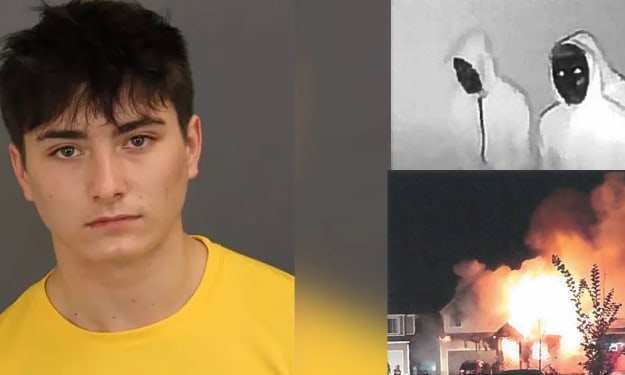"The Art of Deception"
The climax of a detective story involves the detective revealing the identity of the culprit and explaining how they solved the mystery.

Detective Amelia Clarke sat in her dimly lit office, the soft glow of her desk lamp casting long shadows across the room. She had spent weeks unraveling the enigma that was the Baron's stolen painting, a priceless masterpiece that had vanished from the walls of the city's most prestigious art gallery.
The painting in question, "The Whispering Muse," was a renowned work of art, rumored to hold a hidden message that had eluded scholars for centuries. The gallery curator, Simon Hartley, had reported it missing, and he had called on Detective Clarke to recover it.
Amelia had poured over the details of the case, scrutinizing every aspect of the theft. The security footage showed nothing but a shadowy figure slipping through the gallery's intricate laser alarm system. The thief had left no fingerprints, no trace of their identity.
As she leaned back in her worn leather chair, Detective Clarke turned her attention to the collection of clues she had gathered over the course of her investigation. Each piece was a puzzle waiting to be solved, and she was determined to assemble them into a coherent picture.
One of the first clues she'd uncovered was a series of cryptic notes that had been left behind at the scene of the crime. The notes were written in a language that appeared to be a combination of ancient symbols and modern code. Amelia had consulted with a linguist, who confirmed that the notes contained references to Greek mythology and art history.
Next, she had interviewed the gallery staff and patrons, looking for any potential witnesses or suspicious behavior. One name had repeatedly come up—Lena Devereux, a renowned art forger known for her ability to create flawless replicas of famous paintings.
Amelia had tracked down Lena and questioned her about the stolen painting. Lena denied any involvement, claiming that she had retired from the world of forgery years ago. But something in Lena's demeanor had raised a red flag for Amelia. She decided to keep a close eye on her.
The detective also focused on Simon Hartley, the curator. Hartley had been overly eager to see "The Whispering Muse" recovered and had displayed an unusual degree of knowledge about the stolen painting's history. His motivations remained unclear, but Amelia couldn't shake the feeling that he was hiding something.
Late one evening, as Amelia was reviewing the case files, a sudden realization struck her like a bolt of lightning. The clues, the notes, the cryptic references—they all pointed to a hidden message within the painting itself. It was as if the thief had wanted to reveal a secret buried within the masterpiece.
The detective rushed to the gallery, her heart pounding with anticipation. She stood before the empty frame that once held "The Whispering Muse," examining it closely. Her fingers traced the edges of the frame, and then, in a moment of inspiration, she turned the frame over.
There, hidden on the back of the painting, was a series of intricate engravings. The symbols and codes mirrored those in the cryptic notes left at the crime scene. Amelia realized that the stolen painting was not just a work of art; it was a map, a key to unraveling a hidden mystery.
Amelia deciphered the engravings, piecing together a complex trail of clues that led her to a small, nondescript bookstore in the heart of the city. Inside, she found a dusty old book, its pages filled with more cryptic symbols and references to Greek mythology. It was clear that the book was connected to the stolen painting.
With the book in her possession, Detective Clarke returned to Lena Devereux, suspecting that the art forger held the missing pieces of the puzzle. Lena confessed that she had been hired to create a replica of "The Whispering Muse" for a mysterious client, but she had no knowledge of the hidden engravings or the book.
Amelia's investigation eventually led her to an underground art society that had been searching for the hidden message within the painting for generations. The society believed that the message held the key to a lost masterpiece by a long-forgotten artist.
As the detective delved deeper into the society's history, she uncovered a shocking revelation—the society's leader was none other than Simon Hartley, the gallery curator. He had orchestrated the theft of "The Whispering Muse" to gain access to the hidden message and locate the lost masterpiece.
Amelia confronted Hartley, who admitted to his involvement in the theft but remained defiant, insisting that he was the rightful guardian of the lost masterpiece. He believed that the stolen painting held the key to unlocking its location.
In a tense standoff at the gallery, Detective Clarke presented her findings to the art society members and Hartley himself. She revealed the true meaning of the hidden message within "The Whispering Muse" and its connection to the lost masterpiece.
As Hartley realized that his quest had been in vain, he reluctantly surrendered the stolen painting. The society members, torn between their loyalty to their leader and their desire to uncover the lost masterpiece, disbanded.
"The Whispering Muse" was returned to its rightful place in the gallery, and the case was closed. Detective Amelia Clarke had solved the mystery, not only of the stolen painting but also of the hidden message that had captivated generations of art enthusiasts.
The big reveal had come full circle, and as the painting was unveiled once more, a hushed crowd of onlookers marveled not only at its beauty but also at the secrets it held. Detective Clarke had unraveled the enigma, and in doing so, she had revealed a hidden world of art and intrigue that few had ever known existed.





Comments
There are no comments for this story
Be the first to respond and start the conversation.